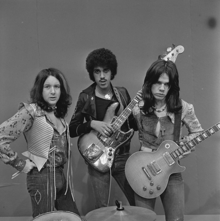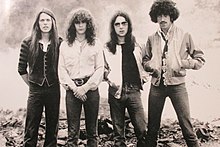Thin Lizzy
The singles "Whiskey in the Jar" (1972), "The Boys Are Back in Town" (1976) and "Waiting for an Alibi" (1979) were international hits, and several Thin Lizzy albums reached the top ten in the UK.
[3] AllMusic critic John Dougan wrote, "As the band's creative force, Lynott was a more insightful and intelligent writer than many of his ilk, preferring slice-of-life working-class dramas of love and hate influenced by Bob Dylan, Bruce Springsteen and virtually all of the Irish literary tradition.
"[4] Two of the founding members of Thin Lizzy, bass guitarist and vocalist Phil Lynott and drummer Brian Downey, met while at school in Dublin in the early 1960s.
An acquaintance of Bell's, Belfast organist Eric Wrixon, also a former member of Them, had also moved to Dublin and joined the showband circuit, but had similar plans to progress towards rock music.
[13] In December 1969, Bell and Wrixon met by chance in a pub in Dublin and found that they shared similar ideas of forming a band, and decided to visit the Countdown Club where they saw Lynott and Downey perform with Orphanage.
[39] Towards the end of 1973, Eric Bell began to feel constricted with the changing style of the group, which left less room for free-form jamming and had people wanting the band to create a follow-up hit to "Whiskey in the Jar".
The new line-up gelled quickly, dropped most of the old songs when they played live,[46] and secured a new record deal with Phonogram, but the resulting album Nightlife was a disappointment for the band due to its soft production and underdeveloped style.
Opening with Seger's "Rosalie", the album showed the first real evidence of the twin guitar sound that would lead the band towards their greatest successes, particularly with the dual harmonies of "Wild One" and both guitarists' soloing on "Suicide".
The album is considered to have financially secured the band, not only enabling them to survive and continue, but also be able to feel the freedom needed to be able to experiment with higher concept thought and Lynott's more lyrically challenging pieces that the group went on to pen.
[55] Lynott was still drawing on Celtic mythology and his own personal experiences for lyric ideas, which dominated Johnny the Fox and the other albums of Thin Lizzy's successful mid-1970s period.
[57] An important tour of the US in December 1976 had to be cancelled when Brian Robertson's hand was injured by a broken bottle during a fight at The Speakeasy Club in London, the night before the band were due to fly.
[62] Before the American tour, Lynott had also invited Irish guitarist Jimi Slevin to "try out a few things" with Thin Lizzy, prompting speculation that the ex-Skid Row member could replace Robertson.
Ure had prior plans to join Ultravox, but had co-written a song, "Get Out of Here", with Lynott on Black Rose: A Rock Legend, and agreed to help Thin Lizzy complete their touring commitments.
[85] Dave Flett had hoped to be made a permanent member of Thin Lizzy but Lynott chose Snowy White, who had played with Pink Floyd and Peter Green.
Snowy White left the band in August 1982, having tired of the disorganised schedules and Lynott's drug problems, although by his own admission he was too restrained and quiet to fit in well with his more raucous bandmates.
[118] "Phil asked Brian Downey and I to re-form Thin Lizzy and we both agreed," recalled guitarist Robin George, on whose album Dangerous Music Lynott had played.
"[119] Lynott died in hospital in Salisbury, Wiltshire, on 4 January 1986, aged 36, having suffered from internal abscesses, pneumonia and septicaemia, brought on by his drug dependency, which led to multiple organ failure.
In 1991, a line-up featuring Robertson and Downey performed with Bobby Tench on lead vocals, ex-Grand Slam member Doish Nagle on guitar and Doug Brockie on bass.
[129] This line-up also played at the Vibe for Philo gig on 4 January 1996, with a number of other notable musicians including Eric Bell, Midge Ure, Brush Shiels, Henry Rollins, and Joe Elliott and Rick Savage from Def Leppard.
Philomena Lynott, her partner Dennis Keeley, and Smiley Bolger (Ireland's Vibe for Philo promoter) were flown to Los Angeles by Ryder to make a personal appearance at the show.
[134] In 2004, Thin Lizzy worked together again, with Sykes and Gorham bringing in ex-Angel bassist Randy Gregg, and drummer Michael Lee, who had played with Robert Plant and The Cult among others.
In a statement, he said, "It's been a very tough time of late for myself and the band, firstly with drummer Tommy Aldridge's injury and now the subsequent decision for John and the rest of the group to go their separate ways.
Joining Gorham was original drummer Brian Downey, long-standing keyboardist Darren Wharton, Def Leppard guitarist Vivian Campbell, and singer Ricky Warwick from The Almighty, while Marco Mendoza returned to fill the bass guitar role.
Two festival dates were initially confirmed: the Ramblin' Man Fair in Maidstone, Kent on 23 July 2016 – at which Midge Ure once again joined them on stage – and the Rock Legends Cruise in Fort Lauderdale, Florida, on 19–23 January 2017.
Jailbreak and Johnny the Fox are double CD editions with the second disc containing outtakes, BBC session recordings and newly remixed versions of select album tracks.
Titled 1976, the set includes original and remixed versions of both albums, two discs of outtakes and radio sessions, plus a live show recorded at The Agora in Cleveland on 5 November 1976.
[162] On 24 January 2025, an album of Eric Bell-era songs is to be released on the Decca label, featuring Lynott's original vocals, Downey's drums, and new acoustic guitar parts by Bell.
[166] Lynott's style of singing also set him apart from other hard rock musicians of the day, utilizing a seemingly casual sense of off-the-beat phrasing "closer to folk or jazz.
This twin lead guitar style was later refined and popularised in the mid-1970s by bands like Judas Priest, and later by the emerging new wave of British heavy metal groups such as Iron Maiden and Def Leppard.
A cover of "Cowboy Song" appears on Sound of White Noise (1993) by Anthrax as a bonus track on the album's Japanese and Australian releases, and as a B-side on some singles of "Only" and "Black Lodge".









